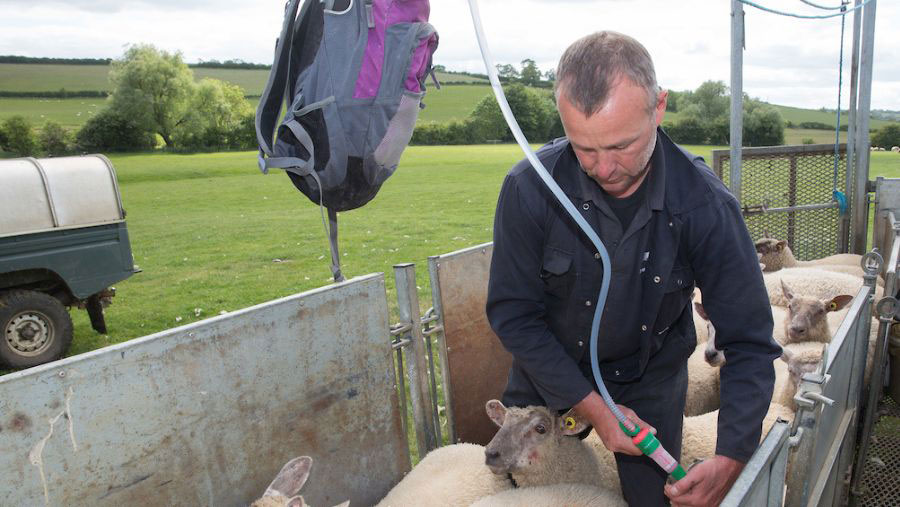Gene mapping breakthrough good news for sheep farms
 © Tim Scrivener
© Tim Scrivener Researchers have taken “a major step forward” in the fight against wormer resistance on sheep farms by mapping the genes linked to drug resistance of the parasitic worm Haemonchus contortus.
The discovery, which was made by scientists from the Wellcome Sanger Institute, the University of Glasgow and the Moredun Research Institute, lays the foundations for understanding how drug resistance arises and how it can be controlled.
See also: Six-step guide to help sheep farmers cut parasite risk
It will also allow new tools to be developed to detect and track resistant strains. Work is already underway to create rapid diagnostic tests and genomic sequencing methods for use in the field.
Haemonchus contortus, known as the barber’s pole worm for its distinctive candy-stripe markings, is a species of parasitic worm known as a helminth.
Helminths can infect people, livestock, and pets.
The widespread resistance to anthelmintic drugs in livestock poses a significant threat to humans, which is why it has been the focus of scientific studies.
Independent sheep consultant and the Sustainable Control of Parasites’ (Scops) spokesperson, Lesley Stubbings, called the breakthrough a “major step forward in detecting anthelmintic resistance on farms”.
She explained: “It is the thing we have been waiting for. If we can have genetic markers that are relatively easy and cheap to operate in the field, it will be easier to farmers to keep check on what is going on.”
Drug resistance study
To pinpoint genes involved, researchers at the Moredun Institute crossed drug-susceptible and multidrug-resistant strains of the parasite.
This was followed by drug treatment with the three most important anthelmintic drug classes used to control the parasite: fenbendazole, levamisole and ivermectin.
The Wellcome Sanger Institute then carried out whole-genome sequencing of crossed parasites and analysed genomes sampled before and after drug treatment.
Together with genomic data from parasites around the world, this allowed them to pinpoint a small number of new and known genes in drug resistance.
Molecular and drug treatment analyses at the University of Glasgow further validated the genomic findings.
Molecular tools for detecting parasites
Roz Laing, one of the authors of the study, published in Cell Reports, said the fact that so few genes are involved in drug resistance was promising as it would allow new tools to detect and track resistant strains relatively quickly.
Currently, farmers rely on efficacy tests to ensure wormers are working. Having pen-side resistance tests could be a game changer and help speed up the delivery of effective treatment plans, as well as help to slow down resistance to wormers.
“These genetic markers could actually be extremely useful if we could walk onto a farm and detect resistance at a really low level and [recommend a treatment course] to keep resistance low for a long period,” said Ms Stubbings.
These tests are still a while off being commercially available and the markers are currently only available for Haemonchus and not other worm species.
However, Ms Stubbings called it a “step in the right direction”.
Stephen Doyle, molecular and computational biologist at the Wellcome Sanger Institute, said: “For at least some drugs, we now have the technologies and genetic data to develop molecular tools for detecting parasites and diagnosing resistance.
“What we now need to show is that these tools add real value for farmers in their existing parasite management strategies.
“Close collaboration between farmers and scientists will speed this up considerably.”
In the meantime, Ms Stubbings said it was vitally important for farmers to continue to adhere to the Scops principles to slow down drug resistance on farms.
What is Haemonchus?
Haemonchus causes anaemia, weight loss, and death, in severe conditions.
Resistance to all worms is growing in UK sheep flocks, but Haemonchus can be particularly difficult to predict and control, says independent sheep consultant Lesley Stubbings.
“Historically, we would have only expected to see it in warmer parts of the country like the South West due to warmer conditions. [Now] we see it on a lot more farms around the country.
“It is very prolific and replicates rapidly in massive amounts – you can go from virtually no Haemonchus to very high numbers within a fortnight. It can really catch farmers out and it is hard to know when to treat.”
Scops has further advice on treatment.
The study can be read in full in Cell Reports.
